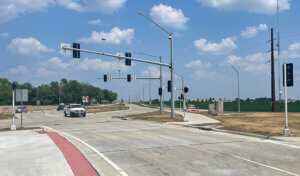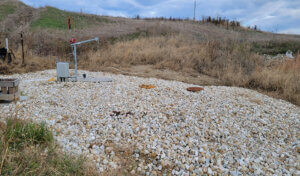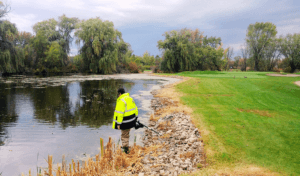
Snyder & Associates Helps Transform Madison’s Golf Landscape
In the heart of Madison, Wisconsin, a remarkable transformation has occurred, reshaping the golfing experience for enthusiasts and professionals alike. Dennis Tizani, the visionary owner of TPC Wisconsin, has spearheaded an ambitious project to revitalize the former Cherokee Country Club. In collaboration with PGA Tour player Steve Stricker, this venture has birthed a world-class golf course and set a long-term vision to impact the community positively.
Behind the scenes of this golfing masterpiece lies the expertise of Snyder & Associates, as our team played a pivotal role in shaping the topography, managing water resources, and ensuring environmental compliance for TPC Wisconsin.
Nurturing Environmental Commitment
The foundation of any successful golf course lies in a thorough understanding of the existing topography and layout. Our team of skilled surveyors conducted a topographic survey of the current key features, which included the waterways, ponds, and wetland areas. The bathymetric survey, or mapping of the natural contours underwater, was done by a boat drone and manually with kayaks. This detailed assessment provided the designers and developers at TPC Wisconsin with crucial information to optimize the course layout, creating a challenging yet harmonious golfing experience.
This spurred the journey to begin with an environmental perspective, as the area earmarked for transformation was once a marsh filled with silt. The restoration project became an opportunity to create a top-tier golf course and revive over 35 acres of degraded wetlands linked to the Cherokee Marsh. The removal of silt and the revival of the wetlands have dramatically increased the stormwater quality of water meandering through the golf course system.
TCP Wisconsin Design Evolution
Steve Stricker, intimately involved in the design process, embarked on a nationwide exploration to understand the nuances of professional golf course design. After examination, the decision was clear: the course needed elevation, vegetation removal, and the restoration of canals and waterways to their original functionality.
Navigating water features seamlessly is essential for golfers; all water crossings facilitate this. Snyder & Associates employed their engineering ability to design efficient culverts. They planned bridge locations that not only enhanced the aesthetic appeal of the course but also ensured the smooth flow of water, mitigating the risk of flooding and erosion.
The original golf course featured numerous perched culverts, where the inlets were positioned higher than the water level, posing a challenge for water and aquatic life to move freely between waterways. With the introduction of the new course design, several enhancements were implemented to address this issue. A total of six bridges were constructed, replacing some of the problematic culverts, while other culverts were strategically lowered within the water level to facilitate the movement of wildlife. Additionally, the culvert diameters were expanded in many areas to promote smoother water flow, contributing to a more ecologically friendly and interconnected environment.
The Challenge of Drainage
A pivotal focus during the design phase was drainage, as Wisconsin’s landscapes are characterized by diverse water bodies, necessitating a robust hydrological strategy. Our experts conducted thorough hydrological studies to understand water movement patterns, prevent any rise in the elevation of the floodplain post-construction of the golf course, and ensure that the overall design harmonized with the natural flow.
While elevating fairways, greens, and tees was part of the design, it necessitated a thoughtful balance to avoid adverse effects. Strategic cuts were made in other sections throughout the course to offset these filled areas. Additionally, waterways underwent enlargement and dredging initiatives, fostering improved water flow and habitat for wildlife. The process was meticulously modeled to abide by floodplain management rules and regulations.
Furthermore, the team took proactive measures to secure the essential floodplain permits required for the project’s execution. This involved engaging with regulatory authorities and presenting a detailed report that adheres to environmental standards and floodplain management guidelines. By obtaining the necessary permits, the team ensured compliance with local regulations, fostering a collaborative relationship with regulatory bodies and affirming the project’s commitment to responsible development and environmental stewardship.
Project Completion: Wrapping Up the Final Details
Within an 8-10 week grassing window, the course was entirely rerouted, re-grassed, and equipped with a new irrigation system. The result is a meticulously crafted golfing paradise, ready to host the PGA Tour Champions American Family Insurance Championship from 2025 onward. Spectator mounding adds to the allure, promising an unforgettable experience for golf enthusiasts and casual spectators.
Dennis Tizani’s vision for TPC Wisconsin goes beyond creating a world-class golf course; it’s about revitalizing the landscape, fostering environmental sustainability, and catalyzing positive change in the community. As the greens of TPC Wisconsin welcome players and spectators, it stands as a testament to the transformative power of collaboration, innovation, and a commitment to excellence in every aspect of the golfing experience.




